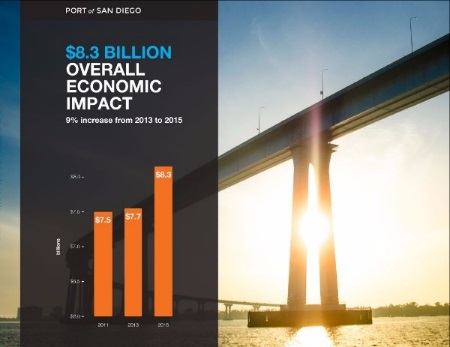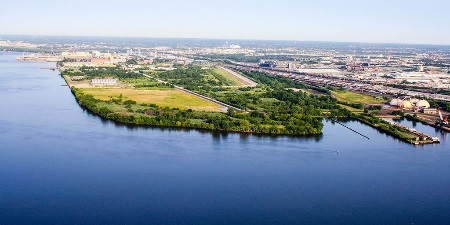Economic Impacts: San Diego, Philadelphia
![]() Print this Article | Send to Colleague
Print this Article | Send to Colleague
Port of San Diego Contributes $8.3B to Regional Economy, Supports 68,300 Jobs
San Diego - The Port of San Diego is a vital economic engine driving $8.3 billion in total economic output and supporting 68,300 jobs in 2015, including multiplier effects, according to an economic impact analysis by Economic & Planning Systems Inc.
The final report, "Economic Impacts of the San Diego Unified Port District in 2015," also revealed that the Port’s total employment impact results in $3.3 billion in labor income.
View the full pdf report (1.85 MB).
Overall, about one in 30 jobs in San Diego County and about 2.5 percent of the gross regional product are attributable to the Port.
"This study reinforces what we see every day on the working waterfront; the Port of San Diego is an economic engine for the San Diego region and its impact continues to grow," said Port Chairman Marshall Merrifield. "Our economic impact will continue to grow with the success of our cruise and cargo businesses, the development boom, and new business lines linked to our leadership in the Blue Economy. All pistons are firing at the Port of San Diego! Our diversified portfolio reflects the strength and diversity of the people of the region."
Business activity from the Port of San Diego also generates more than $100 million in tax revenues in its five member cities: Chula Vista, Coronado, Imperial Beach, National City and San Diego.
Total impact includes direct output as well as indirect and induced output, sometimes called the multiplier effect.
The Port of San Diego’s direct economic output was $5.4 billion, up about 6 percent from 2013, and direct employment was 43,627, up about 10 percent from 2013. "Direct" refers to activity and jobs located at businesses within the Port of San Diego’s jurisdiction.
The Port’s business portfolio is divided into two categories – industrial and maritime commerce (cargo operations, ship-building and repair, manufacturing, cargo- and terminal-related businesses and wholesale), and tourism and commercial activity (hospitality, retail, recreation, and most convention and cruise).
Although industrial and maritime accounted for only 30 percent of direct employment, it generated 50 percent of direct economic output. These large economic numbers for industrial and maritime commerce were driven by the movement of 1.8 million tons of cargo through the Port’s Tenth Avenue and National City marine terminals, and 77 cruise calls with each providing total impact between $600,000 and $2 million. The two maritime cargo terminals alone generated $234 million in direct economic output and 1,600 direct jobs. As for the port’s cruise activity, it generated $42 million in direct economic output and 430 direct jobs.

Photo/Port of San Diego
PA Governor Touts Philadelphia Port Investment to Create Thousands of Middle Class Jobs
Harrisburg, PA — Pennsylvania Governor Tom Wolf on Dec. 21 joined Senator Bob Casey, elected officials and stakeholders to tout a comprehensive Capital Investment Program at the Port of Philadelphia announced in November that will create thousands of jobs by investing more than $300 million in the Port’s infrastructure, warehousing, and equipment. This initiative will double container capacity, position the Port for future growth, improve efficiency, and increase tax revenues when it begins next year and continues through 2020.
"My number one priority is to continue to strengthen Pennsylvania’s economy to support the middle class and this capital investment program will give the Port of Philadelphia the tools it needs to improve its competitive position and create thousands of family-sustaining jobs while increasing state revenues," said Governor Wolf. "With its major economic impacts throughout the state, my administration understands the value of Pennsylvania’s port asset in Philadelphia."
"This is one of the largest economic development projects in the state," Sen. Casey said. "I have worked since I was elected to ensure the deepening of the Delaware River, an investment in job retention and creation for the state."
The program, ranking among the largest investments by a state on the East Coast, will boost three of the busiest sectors of the Port of Philadelphia, including the Packer Avenue Marine Terminal, the Port’s automobile-handling operation, and the Tioga Marine Terminal.
"The state’s $300 million investment is a good deal not just for the Port’s workers and for Philadelphians, but for taxpayers across the entire state," said Philadelphia Mayor Jim Kenney. "This increased capacity will be needed in the years to come, since the deepening of the Delaware River’s main navigation to prepare for bigger ships is scheduled to completed in early 2017. So we are grateful to the Wolf Administration, to state lawmakers, and of course to the hard-working men and women of the Port of Philadelphia."
These improvements will result in doubling container capacity at the Port, provide increased breakbulk (non-containerized) cargo capacity, and bring a substantial increase in automobile-handling capacity. A total direct job increase of 70 percent is projected from the current level of 3,124 to a projected 5,378 direct jobs. Total employment at the Port will also increase, from 10,341 to 17,020, and state and local tax revenues generated will increase from the current $69.6 million to $108.4 million annually.
"The investment in the Philadelphia port will not only provide overdue upgrades to the existing ports, it will also add thousands of jobs to the region," said state Rep. Bill Keller, D-Phila. "I would like to thank Gov. Wolf for securing the funds for this very important project."
About $200 million of the Capital Investment Program will be invested in the Packer Avenue Marine Terminal, the Port of Philadelphia’s largest maritime facility. These improvements will include four new electric post-Panamax container cranes, the relocation of warehouses to facilitate container growth and the construction of new ones, and a deeper 45-foot depth at the terminal’s marginal berths, to match the new 45-foot depth of the Delaware River’s main channel. Electrification throughout the terminal will also be modernized to support electrification of existing diesel cranes and cold ironing capabilities at the terminal (the ability to power without the need for the vessels to burn fuel while docked).
The Governor’s administration worked closely with the Board of Directors of the Philadelphia Regional Port Authority, the Port’s staff, and business and labor leaders throughout the Port to develop the very best, most effective capital program to improve commerce at the Port of Philadelphia, and to prepare the Port to meet industry trends for years to come.
"Once again, the Port of Philadelphia is indebted to Governor Wolf and his administration," said Philadelphia Regional Port Authority (PRPA) Chairman Gerald H. Sweeney. "In the recent past, Governor Wolf had funded the critical final stages of the 45-foot Channel Deepening Project and championed other major port improvements. Now, this $300 million capital investment will enable the Port to significantly grow family sustaining jobs and dramatically expand all our business lines, particularly setting us on a path to more than double our existing container capacity. This investment by the Governor, coupled with the talented dedication of the entire port community, ensures that the Port of Philadelphia will capture a significant share of the increased vessel traffic on the East Coast resulting from the expanded Panama Canal and our deeper channel."
Officials at the Philadelphia Regional Port Authority anticipate an aggressive "shovels in the ground" schedule beginning early next year to make these planned capital improvements.

Photo/Port of Philadelphia
As the latest example of the successful public/private partnerships at the Port, Astro Holdings, Inc., the Tenant of the Packer Avenue Marine Terminal, will also purchase one of the Post-Panamax container cranes for the terminal, as well as dedicating significant privately-owned port acreage, in the form of the Holt-owned 40-acre "Publicker" site located next to the Packer Avenue facility, for container growth through Packer Avenue Marine Terminal.
Officials of the Philadelphia Regional Port Authority (PRPA) expect that these improvements will result in no less than a doubling of the cargo-handling capacity at the terminal, already the busiest and most multi-use terminal at the Port of Philadelphia. Container-handling capacity will especially increase, with a 900,000 TEU capacity immediately resulting from the improvements, scalable to exceed 1.2 million TEU capacity in the future, a significant improvement over the terminal’s current 400,000-plus TEU capacity.
The improvements at the Packer Avenue Marine Terminal, the port’s primary container facility, will occur at about the time that the Delaware Main Channel Deepening Project, which is deepening the port’s main shipping channel from 40 to 45 feet, will be completed. The larger, deeper-draft container vessels that will be able to reach the port because of the deepening project (as well as a recently improved Panama Canal) will now find a terminal that is especially prepared for their needs.
The port’s Automobile Import/Export facility, which currently processes 150,000 cars and employs more than 300 direct workers will also benefit by receiving about $90 million of the governor’s Capital Investment program. Since 2010, Glovis America been the main customer of the Port’s Auto Processing facility, located in South Philadelphia adjacent to the Packer Avenue Marine Terminal, bringing Hyundai and Kia automobiles on vessels for eventual distribution to dealerships throughout the region.
Improvements to the Port’s automobile-handling operation will include the addition of 155 paved and fenced acres above the flood plain at the port’s Southport site; the conversion of the former seaplane hangar at Southport into a second auto-processing site; enhancements at the main auto-processing site at Pier 98 Annex; and the establishment of a framework that provides flexibility for use of the land the Port needs for containers and automobiles, as determined by market demands.
Tioga Marine Terminal will be the third beneficiary of the State Capital Investment Program at the port. $12 million has been earmarked for improvements to the main on-dock warehouse that has been successfully handling and processing Brazilian wood pulp cargoes since 2014. A second warehouse at Tioga will be converted into a food-grade warehouse, allowing the port increase its wood pulp volumes to meet the demands of Pennsylvania companies requiring wood pulp. Improved rail access and the purchase of a second mobile harbor crane will also add capacity for Tioga Marine Terminal.
This capital investment program provides an alternate, more efficient and expeditious solution to reach the port’s goals as embodied in the recent Southport RFP: growing container capacity, accelerating job creation, and capitalizing immediately on the river dredging program ensuring that the port will be competitive and positioned for growth immediately With this capital investment plan, we will have accomplished both the short term and the longer term objectives that were envisioned for Southport as well as the port overall, with flexibilities to continue to grow and shift across many diverse markets. The Commonwealth and the Philadelphia Regional Port Authority remain committed to establishing the best, most effective maritime operations at Southport, and these slated capital improvements at Southport are part of that commitment.

